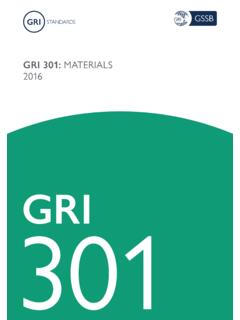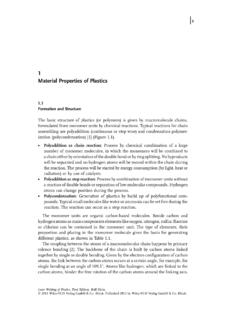Transcription of 661.1 PLASTIC MATERIALS OF CONSTRUCTION
1 Accessed from by Chemic on Fri May 27 13:52:21 EDT 2016. USP 39 Physical Tests / PLASTIC MATERIALS of CONSTRUCTION 493. Therapeutic products come into direct contact with packaging systems and their PLASTIC MATERIALS of CONSTRUCTION as the product is manufactured, stored, and administered. Such contact may result in an interaction between the therapeutic prod- ucts and the packaging systems and its MATERIALS or components of CONSTRUCTION . These interactions must be such that the suitability for use (including its safety and efficacy) of the therapeutic product and the packaging systems is not adversely af- fected by the interaction. Although suitability for use includes several quality aspects of the packaged drug product and its performance, the suitability for use aspect addressed in this chapter is patient safety. Obtaining such a necessary and desirable outcome is facilitated by the use of well-characterized PLASTIC MATERIALS of CONSTRUCTION in components, containers, and packag- ing systems and by the appropriate testing of packaging systems.
2 SCOPE. Establishing the suitability of PLASTIC packaging systems for therapeutic products involves multiple tests and testing proce- dures, as briefly outlined below: material screening: Characterization of a packaging system's MATERIALS of CONSTRUCTION to evaluate ingredients as probable extractables and potential leachables. Such a characterization facilitates the identification of MATERIALS that are suitable for use in packaging systems. Controlled extraction (simulation) study: Worst-case controlled extraction (simulation) study to determine the extent to which extractables may become probable leachables (for additional information, see Assessment of Extractables Associated with Pharmaceutical Packaging/Delivery Systems 1663 ). Product assessment: Actual-case measurement of confirmed leachables in the therapeutic product in the pharmaceutical General Chapters packaging/delivery system intended for the commercial market (for additional information, see Assessment of Drug Product Leachables Associated with Pharmaceutical Packaging/Delivery Systems 1664 ).
3 Additionally, information provided by the vendor(s) of PLASTIC packaging systems and their associated MATERIALS or compo- nents of CONSTRUCTION can facilitate suitability assessments, as such information may be appropriate additions to or surrogates for the results obtained by performing the tests noted previously. The process of manufacturing a packaged therapeutic product is complex. Considering the packaging system specifically, packaging systems typically consist of components that are individually manufactured from PLASTIC MATERIALS of CONSTRUCTION . These individual PLASTIC MATERIALS of CONSTRUCTION are initially generated from reagents that are reacted to produce a base poly- mer, which is then compounded with various additives to produce a base resin. Individual base resins either are MATERIALS of CONSTRUCTION themselves or may be combined with additional additives and processing aids to form a PLASTIC material of con- struction. Testing of these PLASTIC MATERIALS of CONSTRUCTION to establish that they are well characterized and suitable for use, specifically considering safety, in packaging systems is within the scope of this series of chapters and is addressed in PLASTIC MATERIALS of CONSTRUCTION .
4 Individual PLASTIC MATERIALS of CONSTRUCTION are combined to form components of the packaging system. The packaging sys- tem is completed by assembling its various components into its final form. Testing of packaging systems to establish that they are suited for their intended uses, specifically considering safety, is within the scope of this series of chapters and is addressed in PLASTIC Packaging Systems for Pharmaceutical Use . Assembled packaging systems are filled to contain the therapeutic product by various means and at various points in the packaging system manufacturing process, thereby generating the packaged therapeutic product. Testing of packaged thera- peutic products to establish that they are suited for their intended uses is addressed in compendial monographs relevant to the specific therapeutic product and falls outside of the scope of this series of chapters. For more information on the scope of, applicability of, and other topics related to the 661 suite of general chapters, see Evaluation of PLASTIC Packaging Systems and Their MATERIALS of CONSTRUCTION with Respect to Their User Safety Impact 1661.
5 USP39. Add the following: PLASTIC MATERIALS OF CONSTRUCTION . INTRODUCTION. The use of well-characterized MATERIALS to construct packaging systems is a primary means of ensuring that the packaging system is suited for its intended use. MATERIALS are characterized so that their properties and characteristics can be matched to the performance requirements of the packaging system, thus facilitating the intentional selection of appropriate MATERIALS . For the purposes of this chapter, a PLASTIC material of CONSTRUCTION is deemed to be well-characterized for its intended use if the following characteristics have been adequately established: its identity, biocompatibility (biological reactivity), general physico- chemical properties, and composition ( , additives and extractable metals likely to be present). Official from May 1, 2016. Copyright (c) 2016 The United States Pharmacopeial Convention. All rights reserved. Accessed from by Chemic on Fri May 27 13:52:21 EDT 2016.
6 494 PLASTIC MATERIALS of CONSTRUCTION / Physical Tests USP 39. Establishing the potential safety effect of a material of CONSTRUCTION cannot rely on a single testing strategy, because a single testing strategy cannot cover all of the material 's attributes that have a potential safety impact. The chemical testing prescribed in the chapter is orthogonal in that the Physicochemical Tests sections provide a general overview of extracted substances, the Extractable Metals sections address potential sources of elemental impurities; and the information provided by the PLASTIC Addi- tives tests addresses potential organic extractables. Because chemical testing alone may not be adequate to establish a materi- al's suitability for use, chemical testing is augmented by the orthogonal approach of establishing biological reactivity. SCOPE. The purpose of this chapter is to provide test methods and specifications for PLASTIC MATERIALS of CONSTRUCTION used in packag- ing systems.
7 This chapter solely applies to individual PLASTIC MATERIALS and should not be applied to packaging systems or com- ponents consisting of multiple individual PLASTIC MATERIALS . The testing and qualification of PLASTIC packaging systems and com- ponents for pharmaceutical use are covered in PLASTIC Packaging Systems for Pharmaceutical Use . This chapter contains tests, methods, and specifications for the following MATERIALS : cyclic olefins, polyethylene, polypropy- lene, polyethylene terephthalate, polyethylene terephthalate G, and plasticized polyvinyl chloride. Other PLASTIC MATERIALS of CONSTRUCTION can be used in packaging systems if their suitability for use has been established by testing that is consistent with the general procedures and specifications provided in this chapter for the above-mentioned MATERIALS . Alternatively, individual PLASTIC MATERIALS of CONSTRUCTION are deemed to be well characterized and appropriate for use if they are used in a packaging system that meets the requirements in or if the packaging system has been deemed appropriate for pharmaceutical use by the appropriate regulatory authority.
8 Such a conclusion is only valid for the specific packaging system that meets the General Chapters requirements of and cannot be extended to other packaging systems using the same material (or MATERIALS ) of con- struction. If the same material of CONSTRUCTION is used in another packaging system, then its suitability for use in that packaging system must be established. Given the wide variety of MATERIALS and packaging systems available, and the potential for new developments in MATERIALS and packaging systems, it is possible that PLASTIC packaging systems could be constructed from MATERIALS that are not specifical- ly addressed in this chapter. MATERIALS of CONSTRUCTION that are not specifically addressed in this chapter are termed unad- dressed MATERIALS . For an unaddressed material to be deemed compliant with this chapter, it must be characterized in ways that are comparable to those used for the MATERIALS specified in this chapter. Specifically, the unaddressed material of construc- tion must be identified by appropriate methodology and tested for biocompatibility, physicochemical properties, additives, and relevant extracted metals.
9 Specifications must be established for unaddressed MATERIALS , and such specifications should be consistent with the specifica- tions for MATERIALS addressed in this chapter. For example, unaddressed MATERIALS whose aqueous extracts are tested for their total organic carbon (TOC) levels shall have specifications for TOC that are consistent with the TOC specifications for MATERIALS addressed in this chapter. Alternatively, unaddressed MATERIALS may, in justified circumstances, comply with other specifica- tions, subject to approval by an appropriate regulatory authority. The test methods in this chapter are appropriate for their purpose, as evidenced by their longstanding use, and thus they reflect acceptable practices. However, other methods and procedures may be equally suitable. Therefore, alternative test meth- ods and procedures can be used but must be suitable, validated, and equivalent to or better than the compendial methods. Table 1 provides guidance on the appropriate application of the chemical tests and biological reactivity tests for oral and topical dosage forms, which include oral tablets, oral hard and soft gelatin capsules, oral powders, solutions and suspensions, topical powders, and aqueous-based topical solutions and suspensions.
10 Table 2 provides guidance on the appropriate applica- tion of the chemical tests and biological reactivity tests for all other dosage forms. [NOTE For aqueous-based oral drug prod- ucts that contain cosolvents (or if, for any reason, it may be expected to extract greater amounts of substances from PLASTIC packaging components than water), additional extractable information may be needed to address safety issues. If additional information is required, perform Extractable Metals and PLASTIC Additives tests as directed in Table 2.]. Table 1. Guidelines for Application of Tests for Oral and Topical Dosage Forms Biological Reactivity Tests Chemical Tests Perform Identification, Physicochemical, and Extractable Metals tests Provide appropriate reference to the Indirect Food Additive regula- Perform Biological Reactivity Tests, In Vitro 87 tions in 21 CFR 174 186, specifically those addressing the purity MATERIALS that meet the requirements of this test are not required criteria and limitations pertaining to use to undergo testing as described in Biological Reactivity Tests, In Vivo MATERIALS that do not meet these requirements are not suitable for 88 packaging for these dosage forms unless the MATERIALS are estab- MATERIALS that do not meet the requirements of the in vitro test are lished to be suitable by other means that have been approved by not suitable for these dosage forms an appropriate regulatory authority Official from May 1, 2016.


